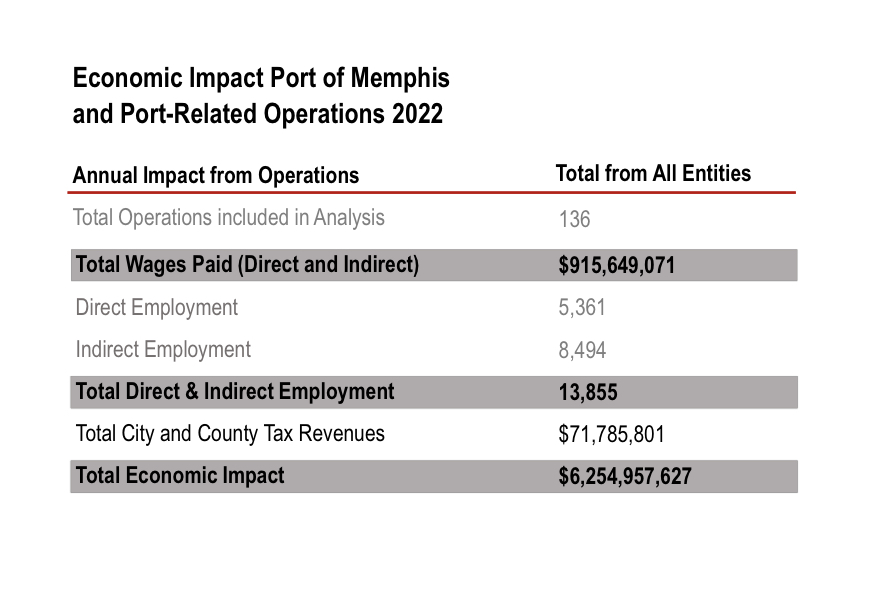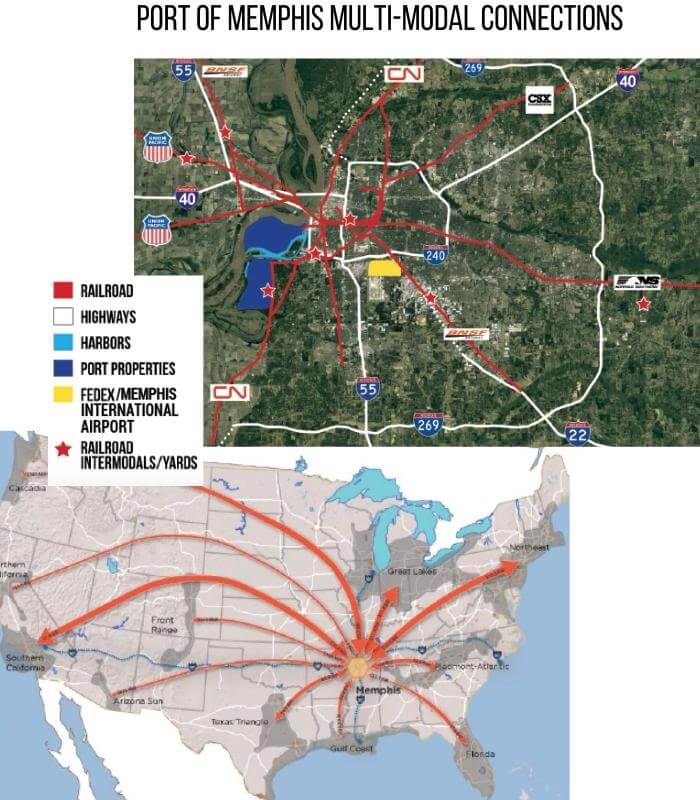
International Port of Memphis
Goal: Attracting businesses and industries with unique transportation needs
The International Port of Memphis is the second largest inland port on the shallow draft portion of the Mississippi River, and the 5th largest inland port in the United States. The Port manages Presidents Island, a 1,000-acre industrial park, and Pidgeon Industrial Park which consists of 5,500 levee protected acres. The Port and its entities offer exceptional rail, road, and water connectivity.

International Port of Memphis
Goal: Attracting businesses and industries with unique transportation needs
The International Port of Memphis is the second largest inland port on the shallow draft portion of the Mississippi River, and the 5th largest inland port in the United States. The Port manages Presidents Island, a 1,000-acre industrial park, and Pidgeon Industrial Park which consists of 5,500 levee protected acres. The Port and its entities offer exceptional rail, road, and water connectivity.

International Port of Memphis
Goal: Attracting businesses and industries with unique transportation needs
The International Port of Memphis is the second largest inland port on the shallow draft portion of the Mississippi River, and the 5th largest inland port in the United States. The Port manages Presidents Island, a 1,000-acre industrial park, and Pidgeon Industrial Park which consists of 5,500 levee protected acres. The Port and its entities offer exceptional rail, road, and water connectivity.
Jump to a section:
Jump to a section:

About the International Port of Memphis
The International Port of Memphis, which includes Presidents Island and Pidgeon Industrial Park, is the second largest inland port on the shallow draft portion of the Mississippi River, and the 5th largest inland Port on the lower Mississippi.
The International Port of Memphis covers the Tennessee and Arkansas sides of the Mississippi River from river Mile 725 to mile 740. Within this 15 mile reach, there are 68 water fronted facilities, 37 of which are terminal facilities moving products such as: petroleum, tar, asphalt, cement, steel, coal, salt, fertilizers, rock & gravel, and of course grains.
Economic Impact and the
International Port of Memphis
The Port of Memphis is the second largest inland port on the Mississippi River. It consists of three separate slack-water harbors: Pidgeon Industrial Harbor and McKellar Lake Harbor just south of downtown Memphis and Wolf River Harbor in the northern part of the city. Port properties include two major industrial parks, Pidgeon Industrial Park and Presidents Island.
Waterborne operations within the Port of Memphis handled 12.2 million short tons in 2016. The value of products handled through the Port of Memphis has increased significantly over the past decade as more manufacturing operations use the Port for transporting finished components.
Home to 7 Fortune 1,000 Companies
Commissioned by the Memphis Shelby County Port Commission, the December 2018 Economic Impact Study looked to quantify the impact of the Port of Memphis on the economy of Memphis and Shelby County. In this study, impact is measured in terms of dollar value of total economic output, direct and indirect jobs supported, and local tax revenues generated as a result of all business activity related to The Port of Memphis.
Economic Impact and the
International Port of Memphis
The Port of Memphis is the second largest inland port on the Mississippi River. It consists of three separate slack-water harbors: Pidgeon Industrial Harbor and McKellar Lake Harbor just south of downtown Memphis and Wolf River Harbor in the northern part of the city. Port properties include two major industrial parks, Pidgeon Industrial Park and President’s Island.
Waterborne operations within the Port of Memphis handled 12.2 million short tons in 2016. The value of products handled through the Port of Memphis has increased significantly over the past decade as more manufacturing operations use the Port for transporting finished components.
Home to 7 Fortune 1,000 Companies
Commissioned by the Memphis Shelby County Port Commission, the December 2018 Economic Impact Study looked to quantify the impact of the Port of Memphis on the economy of Memphis and Shelby County. In this study, impact is measured in terms of dollar value of total economic output, direct and indirect jobs supported, and local tax revenues generated as a result of all business activity related to The Port of Memphis.
By the Numbers
Economic Impact Study
Generated
Total Annual
Economic Impact
Created
Direct Jobs
Created
Indirect Jobs
Generated
Total Annual Tax Revenue
By the Numbers
Economic Impact Study
Generated
Total Annual
Economic Impact
Created
Direct Jobs
Created
Indirect Jobs
Generated
Total Annual Tax Revenue
By the Numbers
Economic Impact Study
Generated
Total Annual
Economic Impact
Created
Direct Jobs
Created
Indirect Jobs
Generated
Total Annual Tax Revenue
Vital Statistics
- 2nd largest Port in Lower Mississippi River
- $6.25 Billion total economic impact
- Created 5,361 direct jobs
- Created 8,494 indirect jobs
- Generated $71.8 million Total Annual Tax Revenue (city and county)


Distribution/Logistics & Strategic Location
Because of its central North American location and transportation infrastructure, Memphis is known worldwide for its multi-modal distribution and logistics capabilities. The Port of Memphis is the central element in that transportation infrastructure.

Distribution/Logistics & Strategic Location
Because of its central North American location and transportation infrastructure, Memphis is known worldwide for its multi-modal distribution and logistics capabilities. The Port of Memphis is the central element in that transportation infrastructure.

Strategic Location
Unique North American confluence of north-south and east-west facilities:
- Interstate highways
- Class 1 rail lines
- Mississippi River & inland waterways
- Memphis International
- Airport/FedEx Headquarters and
- Global Hub
- Energy pipelines
#1
Busiest Cargo Airport
447.7K
Workforce in Shelby County
5
Class I Railroads







